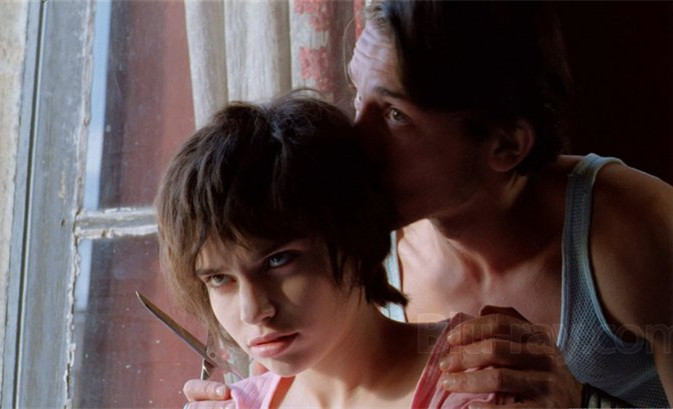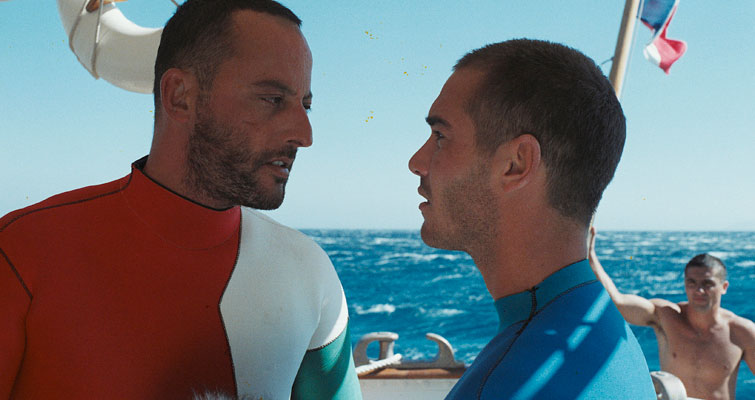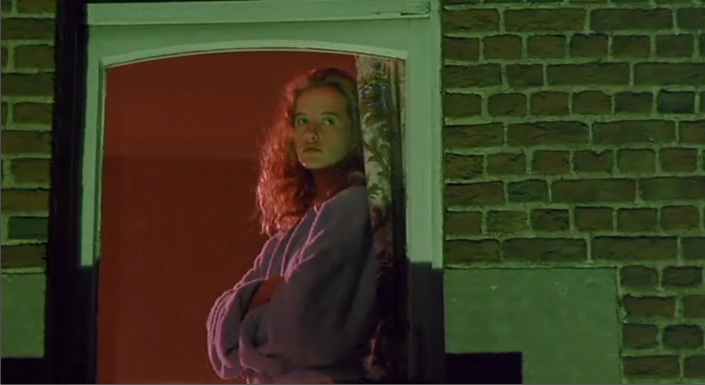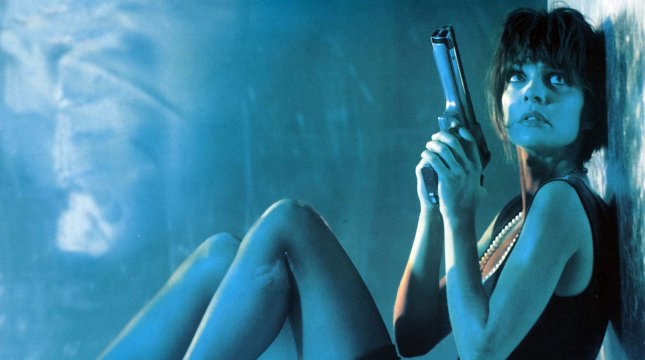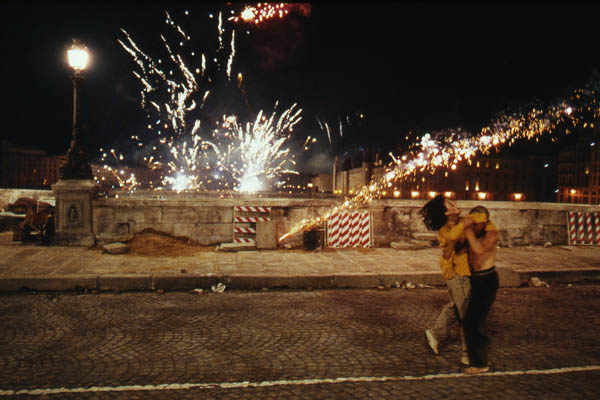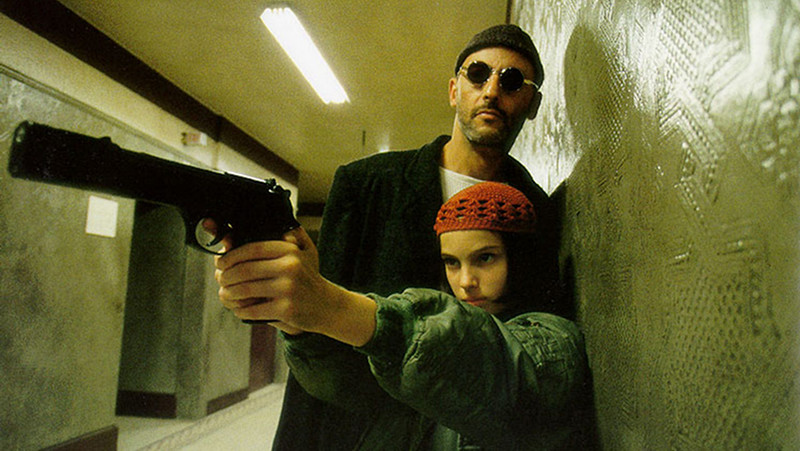6. 37°2 le matin aka Betty Blue (1986)
In many ways, this is the definitive Cinéma du Look film and in many ways exemplifies the best and worst of its excesses. A road movie about two star-crossed lovers Zorg (Jean-Hughes Anglade) and Betty (Béatrice Dalle), it echoes Godard’s À Bout de Souffle, only these lovers aren’t escaping from the police but their own frustrations about artistic rejection and in Betty’s case, doomed maternal instincts.
Like Godard’s gendarmes, the frustrations are waiting for them around every corner and there is little hope of a happy ending. The film’s personality is as split as Betty’s. A comic scene in which Zorg prepares a pizza covered in scraps from the bin for a mouthy diner, ends suddenly with Betty stabbing said diner with a fork when she complains about her lacklustre service – well, they didn’t have TripAdvisor back in 1986.
Jean-Jacques Beineix roared back to international acclaim with Betty Blue after his sophomore effort, Moon in The Gutter appealed to no one, especially its star Gérard Depardieu back in 1983. Beineix’s visuals are as mesmerising as ever, particularly the opening act set among a village of beach huts on stilts. His greatest coup was casting Béatrice Dalle, a wild untameable icon of a star who seemingly burned herself out in this, her extraordinary, unforgettable debut.
5. Le Grand bleu aka The Big Blue (1988)
The critical brickbat that Cinéma du Look was all style and no substance could more reasonably be levelled at Luc Besson’s free-diving epic than at any other.
Then again, it is a film about two men who would rather be underneath the waves than putting up with anything as trivial and tedious as the company of human beings. Childhood friends Jacques (Jean-Marc Barr) and Enzo (Jean Reno) are now adult rivals in a diving competition that involves slowing your heart-rate and dropping to barely fathomable depths without oxygen.
This is pure Cinéma du Look (or Luc), a film without a single memorable line of dialogue, in which the main character is happier communing, dolphin-like with his fellow sea-creatures than interacting with people, and in which Rosanna Arquette has no idea what to do with herself. And yet the film successfully achieves what it sets out to do, namely seduce the viewer into a Zen-like torpor, floating peacefully as though one were in an immersion tank.
Eric Serra’s score is essential and the ocean has never been photographed so majestically – this film is to the scuba-diving community what Big Night is to chefs. Despite a critical roasting, this was the biggest movie of the decade in France. Besson would return to his bullets and car chases very soon afterwards, but this was a moment of tranquil reflection in between the gunfire.
4. Roselyne et les lions (1989)
Beineix’s follow-up to Betty Blue continued the road movie theme and retained a pair of star-crossed lovers for the journey. Alas, where Betty Blue had Béatrice Dalle – the actress equivalent of a hand-grenade with a loose pin rolling around on the floor of a school bus – here instead, Beineix casts Isabelle Pasco as Roselyne, an aspiring lion tamer who runs away with Thierry (Gérard Sandoz) in the hope that they can achieve lion-taming success in the circus.
Whilst being superhumanly beautiful, Pasco lacks any intensity and her character (and that of Thierry) is far too slight to shoulder over two hours of plotless rambling. Perhaps Beineix was blinded by his adoration for Pasco – they were lovers at the time – but he still manages to create a wistful, albeit soporific evocation of innocent love on the run. For connoisseurs of 80s kitsch, the lion taming scenes in the circus would have not looked out of place in a Stevie Nicks video.
3. La Femme Nikita aka Nikita (1990)
Besson returned to his action milieu with this superb urban thriller which continues to extend its influence today (so far there has been one surprisingly good remake, The Assassin in 1993, and two TV shows). Anne Parrilaud is stunning, both as a borderline feral street punk who is sentenced to death for murdering a cop, and as the hyper-trained government agent she is subsequently transformed into.
Besson had honed his skills as an action director by now, creating several thrilling edge-of-the-seat scenes and giving cinematographer Thierry Arbogast as many blue filters as were available in France at the time.
The vignette where Jeanne Moreau takes Nikita aside from her death-dealing training to teach her how to put on make-up and eyeliner is just as memorable as the amazing stunt work. When love raises its head (and it always does in the Cinéma du Look films) with the arrival of Jean-Hughes Anglade (as it usually is), it is uncharacteristically allowed to save the day: an aberration that Leos Carax would rectify a year later.
2. Les Amants du Pont-Neuf (1991)
Leos Carax’s encyclopaedic knowledge of cinema and his mastery of cinematic techniques combined to create this extraordinary assemblage of montages and images that will stay with you forever.
Denis Lavant and Juliette Binoche are reunited as respectively Alex, a Parisian street performer and Michele, a socialite painter with mental difficulties and an eye-patch. They fall in love and take refuge among the homeless characters that live under the Pont-Neuf, Paris’ oldest bridge.
Carax throws his entire box of tricks at this film and the effect is mesmerising; a balletic love-letter to cinema itself. An off kilter ending doesn’t sour the two previous exhilarating hours, and was itself a result of the pressures Carax was under at the time – due to the exorbitant cost of rebuilding the Pont-Neuf as a movie set, this seemingly simple tale of love blossoming and withering across the social divide somehow became the most expensive French film ever made at that time. As such, it received something of a stern rebuke for its profligacy.
1. Léon: The Professional (1994)
Carax made one more film, the controversial incest drama Pola X in 1999, then vanished to the disappointment of many who saw him as the saviour of French cinema – he returned in 2012 with Holy Motors. Jean-Jacques Beineix never seemed to recover from the negative critical reaction to Roselyne et Les Lions and turned his interest towards documentaries, including Locked-In Syndrome which formed the basis for the acclaimed film The Diving Bell and The Butterfly (2007).
With The Fifth Element in 1997, Luc Besson effectively became France’s Steven Spielberg, but his previous film represented the gangplank between French cinema and Hollywood and drew a final veil across the Cinéma du Look.
Jean Reno returns as a child-like ultra-efficient hit man living in New York (a variation on his character in La Femme Nikita; they are both ‘Cleaners’). He reluctantly takes in a young girl (Natalie Portman, unbelievable in her debut) who has just been orphaned by a gang of corrupt cops led by the deranged, Beethoven-loving Stansfield (Gary Oldman at his white-hot peak).
It is over the top and cartoonish – Matilda seems to take all of twenty minutes to get over the fact that her baby brother has just been machine-gunned to death – but it is heightened, wired, enormously entertaining and anchored by genuine sweetness; a combination that is often to be found in the Cinéma du Look.
Author Bio: Cai is a food and film writer, with articles published in The Chap, Fire & Knives, Gin & It and Cinema Retro. He is a features writer for HeyUGuys.co.uk and has yet to get over the Jaws obsession which consumed him as a callow youth.
